Kampung Balai is a village in Bachok, Kelantan, Malaysia. It is located approximately 20 kilometers southeast of Kota Bharu.
Kampung Balai is a village in Bachok, Kelantan, Malaysia. It is located approximately 20 kilometers southeast of Kota Bharu.
While ‘’Balai’’ means ‘’hall’’ in Malay, there is no known historical correlation between the village and ‘’hall’’.
However, according to local inhabitants, “Balai” is derived from ‘’Ban Malai” or ‘’flower village’’ in Thai language. It is believed that the low-lying area where the rice field was, now planted with tobacco, was once a shallow lake filled with flowering lotus.
The Thais of this village are believed to be originated from central Thailand more than 200 years ago when Kelantan was a tributary of the Kingdom of Siam. Their spoken Thai language is distinctly different from other Thais in Kelantan who generally speak the southern “Tak Bai" Thai language.
The village was most probably opened by these Thais or the Chinese.
The Chinese, mostly from Fujian, China came to the village probably at the same time with the Thais to develop the village. Some of the Chinese are of eighth or ninth generation descendants. Virtually all of them have lost contact with their ancestral roots in China.
The population of Balai is about 450, almost all of them are of Thai and Chinese descents.
The lingua franca among the villagers is mainly Thai although all the Chinese and most of the Thais could also speak, to some degree of competency, Kelantan Hokkien (Min Nan). All of them are fluent Malay speakers and some, especially the younger generation, could converse in Mandarin as well.
They are predominantly Buddhists. The Chinese also observe traditional Chinese practices.
There are three Buddhist temples in the village i.e. Wat Phathumviharn, Wat Phithikyan Phutthaktham and a Kuan Yin temple located at seaside facing the South China Sea.
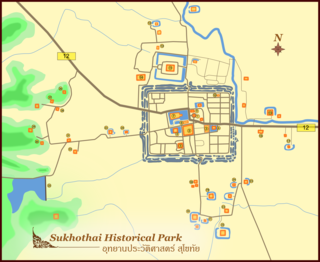
Sukhothai Historical Park covers the ruins of Sukhothai, literally 'dawn of happiness', capital of the Sukhothai Kingdom in the 13th and 14th centuries, in north central Thailand. It is near the city of Sukhothai, capital of Sukhothai Province.
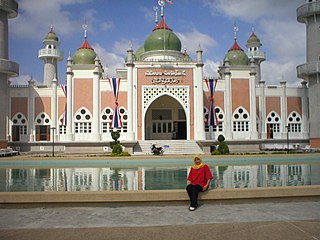
Pattani is one of the southern provinces of Thailand. Neighboring provinces are Narathiwat, Yala, and Songkhla. Its capital is the town of Pattani.

Narathiwat is one of the southern provinces (changwat) of Thailand. Neighboring provinces are Yala and Pattani. To the south it borders the Malaysian state of Kelantan and Perak. The southern railway line ends in this province, which is one of the nation's four provinces that border Malaysia. The province features a range of cultures as well as natural resources, and is relatively fertile. Narathiwat is about 1,140 kilometers south of Bangkok and has an area of 4,475 km2 (1,728 sq mi). Seventy-five percent of the area is jungle and mountains and has a tropical climate.
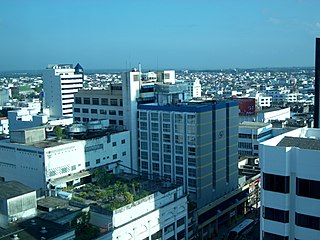
Songkhla is one of the southern provinces (changwat) of Thailand. Neighboring provinces are Satun, Phatthalung, Nakhon Si Thammarat, Pattani, and Yala. To the south it borders Kedah and Perlis of Malaysia.

Kelantan is a state in Malaysia. The capital is Kota Bharu and royal seat is Kubang Kerian. The honorific name of the state is Darul Naim . Kelantan is located in the north-eastern corner of the peninsula. Kelantan, which is said to translate as the "Land of Lightning", is an agrarian state with green paddy fields, rustic fishing villages and casuarina-lined beaches. Kelantan is home to some of the most ancient archaeological discoveries in Malaysia, including several prehistoric aboriginal settlements.

Kedah, also known by its honorific Darul Aman or "Abode of Safety" is a state of Malaysia, located in the northwestern part of Peninsular Malaysia. The state covers a total area of over 9,000 km2, and it consists of the mainland and the Langkawi islands. The mainland has a relatively flat terrain, which is used to grow rice, while Langkawi is an archipelago, most of which are uninhabited islands.

Terengganu, formerly spelled Trengganu or Tringganu, is a sultanate and constitutive state of federal Malaysia. The state is also known by its Arabic honorific, Dāru l-Īmān. The coastal city of Kuala Terengganu which stands at the mouth of the broad Terengganu River is both the state and royal capital as well as the largest city in Terengganu. There are many islands located close to the coast of Terengganu state, such as Perhentian Islands and Redang Island.

Srivijaya was a Buddhist thalassocratic empire based on the island of Sumatra, which influenced much of Southeast Asia. Srivijaya was an important centre for the expansion of Buddhism from the 7th to the 12th century AD. Srivijaya was the first unified kingdom to dominate much of the Malay Archipelago. The rise of the Srivijayan Empire was parallel to the end of the Malay sea-faring period. Due to its location, this once-powerful state developed complex technology utilizing maritime resources. In addition, its economy became progressively reliant on the booming trade in the region, thus transforming it into a prestige goods-based economy.
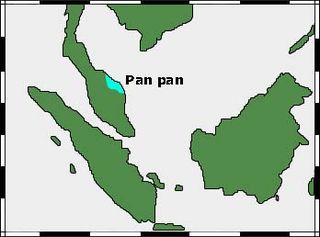
Pan Pan or Panpan is a lost small Hindu Kingdom believed to have existed around the 3rd to 7th century CE. It is believed to have been located on the east coast of the Malay peninsula, with opinion varying from somewhere in Kelantan or Terengganu, in modern-day Malaysia to the vicinity of Amphoe Phunphin, Surat Thani Province, in modern Thailand. It is speculated to be related to Pan tan i, which occupied the same area many centuries later, and has some differences in culture and language to other Malay regions nearby.
Kelantan-Pattani Malay is an Austronesian language of the Malayic subfamily spoken in the Malaysian state of Kelantan and the neighbouring southernmost provinces of Thailand. It is the primary spoken language of Thai Malays, but is also used as a lingua franca by ethnic Southern Thais in rural areas, Muslim and non-Muslim and the Sam-Sam, a mostly Thai-speaking population of mixed Malay and Thai ancestry.

Wat Suthat Thepwararam is a Buddhist temple in Bangkok, Thailand. It is a royal temple of the first grade, one of ten such temples in Bangkok. Construction was begun by King Rama I in 1807. In the beginning, it was initially called "Wat Maha Sutthawat" (วัดมหาสุทธาวาส) and was located in the combretum grove. Further construction and decorations were carried out by King Rama II who helped carve the wooden doors, but the temple was not completed until the reign of King Rama III in 1847 or 1848. This temple contains the Buddha image Phra Sri Sakyamuni which have been moved from Sukhothai Province. At the lower terrace of the base, there are 28 Chinese pagodas which symbolize the 28 Buddhas born on this earth. Wat Suthat also contains Phra Buddha Trilokachet in the ubosot and Phra Buddha Setthamuni in the Sala Kan Parian.

Buddhism in Cambodia or Khmer Buddhism has existed since at least the 5th century. In its earliest form it was a type of Mahāyāna Buddhism. Today, the predominant form of Buddhism in Cambodia is Theravada Buddhism. It is enshrined in the Cambodian constitution as the official religion of the country. Theravada Buddhism has been the Cambodian state religion since the 13th century .As of 2013 it was estimated that 97.9 percent of the population was Buddhist.

Bachok District is an administrative division of Kelantan, Malaysia. It is located approximately 25 km east of Kota Bharu.

The architecture of Thailand is a major part of the country's cultural legacy and reflects both the challenges of living in Thailand's sometimes extreme climate as well as, historically, the importance of architecture to the Thai people's sense of community and religious beliefs. Influenced by the architectural traditions of many of Thailand's neighbors, it has also developed significant regional variation within its vernacular and religious buildings. Although Siam urged to identify themselves as a modernized state, Western culture and influence was undesirable and inevitable. In an attempt to become distinguished, Thailand's ruling elite gravitated toward selective Modernization to avoid the undesired Western influence.

The Malaysian Siamese or Thai Malaysians are an ethnicity or community principally exists in Northern Peninsular Malaysia which is a relatively homogeneous cultural region to Southern Burma and Southern Thailand but was separated by the Anglo-Siamese Treaty of 1909 between the United Kingdom and the Kingdom of Siam. The treaty established the modern Malaysia-Thailand Border which starts from Golok River in Kelantan and ends at Padang Besar in Perlis. In 2014, there were nearly 70,000 people self-identifying as "Siamese" or "Thai" who held Malaysian nationality. This number excludes the senior citizen Siamese who live in Malaysia but do not hold Malaysian citizenship because of political constraint.

Wat Yannawa (Thai:วัดยานนาวา, RTGS: Wat Yannawa, commonly known in English as “The boat temple”, is a Buddhist temple in Bangkok on Charoenkrung Rd, Sathorn district. This temple has a long history from the Ayutthaya era to the present. During the reign of King Rama I, the ubosot was built and named "Wat Yannawa". Then, King Rama III built a temple building in the shape of a Chinese junk ship, giving the temple the nickname the "boat temple". The part of architecture inside of this temple is about the room that people pray, ubosot that enshrined the Buddha images and the pictures that draw in the style of “Loi Prathip Royal Lantern Festival”. The part of architecture outside is about the building that enshrined Buddha relic from Sri Lanka and has the Goddess of Mercy in front of the building.

Malaysia is a multicultural and multiconfessional country, whose official religion is Islam. As of the 2010 Population and Housing Census, 61.3 percent of the population practices Islam; 19.8 percent Buddhism; 9.2 percent Christianity; 6.3 percent Hinduism; and 3.4 percent traditional Chinese religions. The remainder is accounted for by other faiths, including Animism, Folk religion, Sikhism, Baháʼí Faith and other belief systems. Numbers of self-described atheists in Malaysia are few; the state has come under criticism from human rights organisations for the government's discrimination against atheists, with some cabinet members saying that "the freedom of religion is not the freedom from religion".
Wat Photivihan or Wat Yamu, is a Thai temple in Tumpat District, Kelantan, Malaysia. It is one of 25 temples found in Tumpat and is one of the most popular in the country.

A wat is a type of Buddhist temple and Brahminical temple in Cambodia, Laos, East Shan State, Yunnan and Thailand. The word wat is a thai word that was borrowed from Sanskrit vāṭa, meaning 'enclosure'. The term has varying meanings in each region, sometimes referring to a specific type of government-recognised or large temple, other times referring to any Buddhist or Brahminical temple.
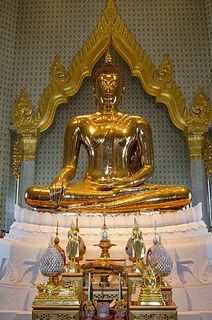
The Golden Buddha, officially titled Phra Phuttha Maha Suwanna Patimakon, commonly known in Thai as Phra Sukhothai Traimit, is a gold Maravijaya Attitude seated Buddharupa statue, with a weight of 5.5 tonnes. It is located in the temple of Wat Traimit, Bangkok, Thailand. At one point in its history the statue was covered with a layer of stucco and coloured glass to conceal its true value, and it remained in this condition for almost 200 years, ending up as what was then a pagoda of minor significance. During relocation of the statue in 1955, the plaster was chipped off and the gold revealed.
Coordinates: 6°06′05″N102°22′23″E / 6.1015°N 102.373°E